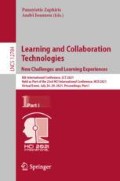Abstract
The creativity of individuals is manifested through the products they are able to create, so that the attributes of a product also characterize the individual who created it. Therefore, a way of measuring the creativity of an individual is evaluating and measuring the creative attributes of the products he or she created. This is the basis of the new model we propose to measure creativity. The main elements of the model are the product, its creator and the evaluators that assess it. The products and their creators are characterized by an open set of measurable attributes, identified from the literature. We have also introduced a social way of evaluation, so that large amounts of evaluators could participate in the process. The work of the evaluators is assessed by assigning them a level of confidence. This level of confidence is assigned and updated considering the expertise of the evaluator but also his or her behaviour during the evaluation process. The combination of a large set of evaluators, their anonymity, and their assessment, have led to a more objective and unbiased system of evaluation and measuring.
Access this chapter
Tax calculation will be finalised at checkout
Purchases are for personal use only
References
Sternberg, R.J., Lubart, T.I., Kaufman, J.C., Pretz, J.E.: Creativity. In: Holyoak, K.J., Morrison, R.G. (eds.) The Cambridge Handbook of Thinking and Reasoning, pp. 351–370. Cambridge University Press, New York (2005)
Besemer, S.P., O’Quin, K.: Confirming the three-factor creative product analysis matrix model in an American sample. Creat. Res. J. 12, 287–296 (1999). https://doi.org/10.1207/s15326934crj1204_6
MacKinnon, D.W.. : In Search of Human Effectiveness. Creative Education Foundation, Buffalo (1978)
Horn, D., Salvendy, G.: Product creativity: conceptual model, measurement and characteristics. Theor. Issues Ergon. Sci. 7, 395–412 (2006). https://doi.org/10.1080/14639220500078195
Sternberg, R.J., Lubart, T.I.: La creatividad en una cultura conformista/Creativity in a Conformist Culture: UN Desafio a Las Masas (Spanish Edition). AbeBooks. ISBN: 8449303400. https://www.abebooks.com/9788449303401/creatividad-cultura-conformista-Creativity-Conformist-8449303400/plp. Accessed 06 May 2018
Amabile, T.M.: Social psychology of creativity: a consensual assessment technique. J. Pers. Soc. Psychol. 43, 997–1013 (1982). https://doi.org/10.1037/0022-3514.43.5.997
Taylor, I.A., Sandler, B.E.: Use of a creative product inventory for evaluating products of chemists. Proc. Annu. Conv. Am. Psychol. Assoc. 7, 311–312 (1972)
Besemer, S.P., Treffinger, D.J.: Analysis of creative products: review and synthesis. J. Creat. Behav. 15, 158–178 (1981). https://doi.org/10.1002/j.2162-6057.1981.tb00287.x
Johnson, R., Kuby, P.: Elementary Statistics. Brooks/Cole, CENGAGE Learning (2012)
Likert, R.: A technique for the measurement of attitudes. Arch. Psychol. 22(140), 55 (1932)
Besemer, S.P.: Creating Products in the Age of Design: How to Improve Your New Products Ideas! New Forum Press, Stilwater (2013)
Krosnick, J.A., Presser, S.: Question and questionnaire design. In: Marsden, P.V., Wright, J.D. (eds.) Handbook of Survey Research. Emerald, Bingley (2010)
Author information
Authors and Affiliations
Corresponding author
Editor information
Editors and Affiliations
Rights and permissions
Copyright information
© 2021 Springer Nature Switzerland AG
About this paper
Cite this paper
Guillem-Aldave, C., Molina-Carmona, R. (2021). A Social, Virtual and Open Model for Measuring Creativity. In: Zaphiris, P., Ioannou, A. (eds) Learning and Collaboration Technologies: New Challenges and Learning Experiences. HCII 2021. Lecture Notes in Computer Science(), vol 12784. Springer, Cham. https://doi.org/10.1007/978-3-030-77889-7_3
Download citation
DOI: https://doi.org/10.1007/978-3-030-77889-7_3
Published:
Publisher Name: Springer, Cham
Print ISBN: 978-3-030-77888-0
Online ISBN: 978-3-030-77889-7
eBook Packages: Computer ScienceComputer Science (R0)

